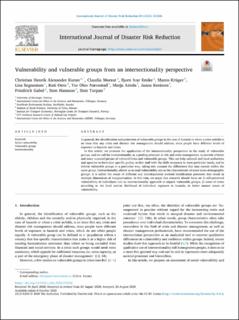| dc.contributor.author | Kuran, Christian Henrik Alexander | |
| dc.contributor.author | Morsut, Claudia | |
| dc.contributor.author | Kruke, Bjørn Ivar | |
| dc.contributor.author | Krüger, Marco | |
| dc.contributor.author | Segnestam, Lisa | |
| dc.contributor.author | Orru, Kati | |
| dc.contributor.author | Nævestad, Tor-Olav | |
| dc.contributor.author | Airola, Merja | |
| dc.contributor.author | Keränen, Jaana | |
| dc.contributor.author | Gabel, Friedrich | |
| dc.contributor.author | Hansson, Sten | |
| dc.contributor.author | Torpan, Sten | |
| dc.date.accessioned | 2021-05-11T11:00:54Z | |
| dc.date.available | 2021-05-11T11:00:54Z | |
| dc.date.created | 2020-10-12T14:06:01Z | |
| dc.date.issued | 2020-11 | |
| dc.identifier.citation | Kuran, C.H.A., Morsut, C., Kruke, B.I. et al. (2020) Vulnerability and vulnerable groups from an intersectionality perspective. International Journal of Disaster Risk Reduction, 50, 101826 | en_US |
| dc.identifier.issn | 2212-4209 | |
| dc.identifier.uri | https://hdl.handle.net/11250/2754856 | |
| dc.description.abstract | In general, the identification and protection of vulnerable groups in the case of hazards or when a crisis unfolds is an issue that any crisis and disaster risk management should address, since people have different levels of exposure to hazards and crises. In this article, we promote the application of the intersectionality perspective in the study of vulnerable groups, and we call for intersectionality as a guiding principle in risk and crisis management, to provide a better and more nuanced picture of vulnerabilities and vulnerable groups. This can help national and local authorities and agencies to formulate specific guides, to hire staff with the skills necessary to meet particular needs, and to inform vulnerable groups in a particular way, taking into account the differences that may coexist within the same group. Intersectionality allows us to read vulnerability not as the characteristic of some socio-demographic groups. It is rather the result of different and interdependent societal stratification processes that result in multiple dimensions of marginalisation. In this vein, we argue that research should focus on 1) self-perceived vulnerability of individuals and an intersectionality approach to unpack vulnerable groups; 2) cases of crises according to the level and/or likelihood of individual exposure to hazards, to better nuance issues of vulnerability. | en_US |
| dc.language.iso | eng | en_US |
| dc.publisher | Elsevier Ltd. | en_US |
| dc.rights | Navngivelse 4.0 Internasjonal | * |
| dc.rights.uri | http://creativecommons.org/licenses/by/4.0/deed.no | * |
| dc.subject | samfunnssikkerhet | en_US |
| dc.subject | sårbarhet | en_US |
| dc.subject | sårbare grupper | en_US |
| dc.title | Vulnerability and vulnerable groups from an intersectionality perspective | en_US |
| dc.type | Peer reviewed | en_US |
| dc.type | Journal article | en_US |
| dc.description.version | publishedVersion | en_US |
| dc.rights.holder | © 2020 The Author(s). | en_US |
| dc.subject.nsi | VDP::Samfunnsvitenskap: 200 | en_US |
| dc.source.pagenumber | 101826 | en_US |
| dc.source.volume | 50 | en_US |
| dc.source.journal | International Journal of Disaster Risk Reduction | en_US |
| dc.source.issue | November | en_US |
| dc.identifier.doi | 10.1016/j.ijdrr.2020.101826 | |
| dc.identifier.cristin | 1838894 | |
| cristin.ispublished | true | |
| cristin.fulltext | original | |
| cristin.qualitycode | 1 | |

